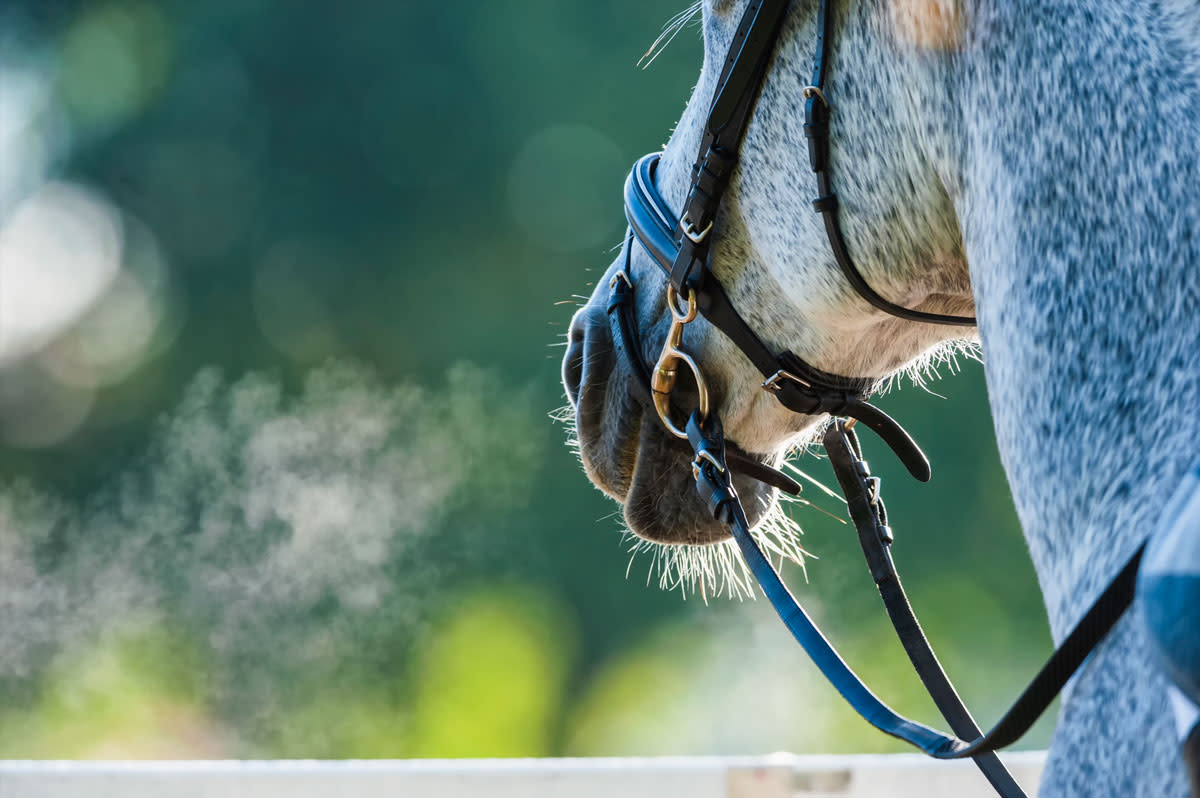
“No wind, no horse” certainly is a concept that describes the potential effects of respiratory disease on an equine athlete. Historically, equine medicine has looked at upper and lower airways as independent systems. Human studies have considered that lower and upper airways are intricately entwined to form “one airway.” More current equine studies have shed light on the idea that both areas of the equine respiratory tract influence and interplay with each other.
You can click on the player below to listen to EquiManagement Editor Kimberly S. Brown reading this article. This audio recording is brought to you by Boehringer Ingelheim Animal Health, makers of Aservo EquiHaler.
A recent retrospective study sought to examine the influence of equine asthma on dorsal displacement of the soft palate (DDSP) [Joó, K.; Povázsai, Á.; Nyerges-Bohák, Z.; Szenci, O.; Kutasi, O. Asthmatic disease as an underlying cause of dorsal displacement of the soft palate in horses, Journal of Equine Veterinary Science (2020)].
The researchers looked at respiratory exam results from 57 pleasure and competition sporthorses exhibiting at least one sign of a respiratory problem: chronic or intermittent cough, nasal discharge, poor performance, increased respiratory efforts, delayed respiratory recovery following exercise and/or exaggerated respiratory effort during exercise.
In addition to a thorough medical exam, endoscopy was done of the larynx and pharynx. Challenge of the upper airway was accomplished with a nasal occlusion test intended to simulate pressure changes expected during intense exercise. Mucus scores of the trachea were evaluated, as were cytology of BAL and tracheal lavages, along with bacterial culturing.
Classification of Horses
Once the data was obtained, the horses were classified as having either mild/moderate or severe asthma. Any individuals with a positive bacterial culture were excluded from the study. The horses were subdivided into four groups:
Group 1: Severe equine asthma
Group 2: Severe equine asthma and DDSP
Group 3: Mild and moderate equine asthma
Group 4: Mild and moderate equine asthma and DDSP
In addition, overground endoscopy was performed on 11 horses in Group 2, and it was noted if any respiratory noise was audible during the exercise.
The results from the resting endoscopy exam were interesting:
- Of 22 horses with mild or moderate equine asthma, 18 had DDSP.
- Of 31 horses with severe equine asthma, 29 had DDSP.
The statistical evaluation noted that “60% of horses with mild or moderate equine asthma and more than 79% of horses with severe equine asthma show DDSP during resting endoscopy examination.”
The horses examined with overground endoscopy coughed intensively when experiencing DDSP but did not exhibit any abnormal respiratory sounds.
None of the horses in this study exhibited any structural abnormalities or deformities of respiratory apparatus, and those with positive bacterial cultures were excluded in order to eliminate neuromuscular weakness associated with an upper respiratory infection. The sport and pleasure horses in this study exhibited DDSP at rest and/or with low-intensity work rather than DDSP occurring due to muscle fatigue or exercise.
Summary
The results of this study are significant because surgical treatment of DDSP with the laryngeal tie-forward procedure to correct dysfunction of the thyrohyoideus muscle would have no effect on horses that have developed DDSP secondary to equine asthma.
The authors suggested that increased negative pressure related to obstruction of the lower respiratory tract might result in negative pressure increases in the upper respiratory tract, leading to DDSP.
This theory was tested on two horses exercised with overground endoscopy by administering atropine for its strong effects on bronchodilation and ability to reverse airway obstruction. The test with atropine failed to improve DDSP in either horse, leading to the suggestion that “the link between equine asthma and DDSP may not be exclusively associated with bronchoconstriction.”
During resting endoscopy and without the nasal occlusion test, DDSP was occurring spontaneously, possibly due to airway inflammation, mucus secretion and weakening of respiratory muscles.
The authors concluded: “DDSP is not exclusively associated with the increasing negative pressure driven by the lower respiratory tract obstruction but rather tailored to the combination of the bronchospasm and inflammation of airway mucosa.”
For these cases, it is recommended that equine asthma be addressed with environmental management and medical treatment before attempting surgical revision.








